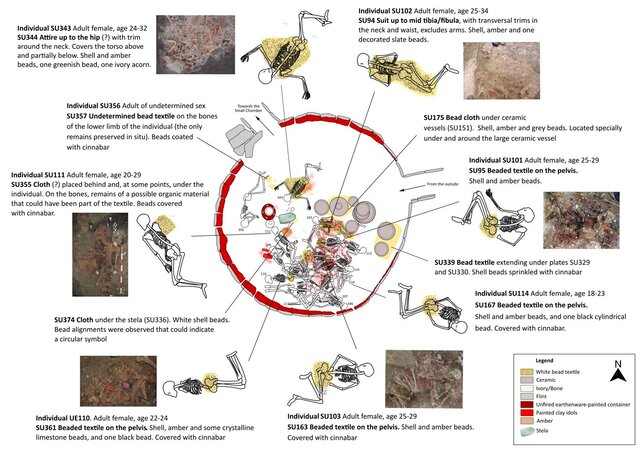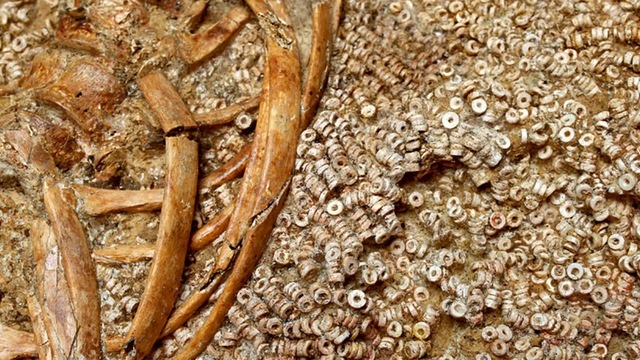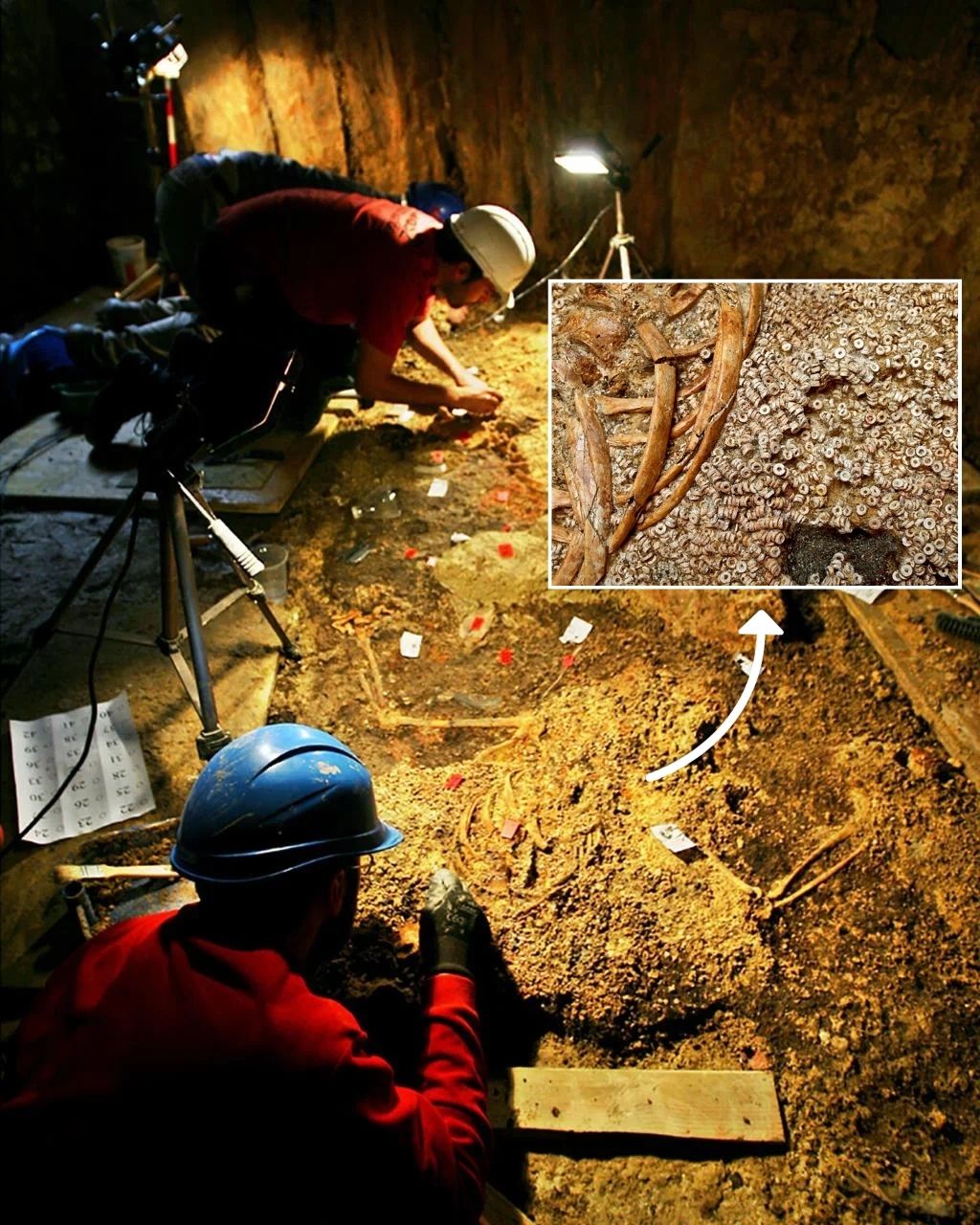In the heart of southern Spain, a remarkable archaeological discovery has shed new light on the lives of Copper Age societies. Hidden within the 5,000-year-old Montelirio tomb, researchers uncovered the largest collection of ancient beads ever found in a single grave. This treasure trove of over 270,000 beads offers a rare glimpse into the intricate social, cultural, and technological fabric of ancient Iberia, revealing the prominence of women in early European civilizations and challenging long-held historical assumptions.
Unearthing the Beads: A Treasure from the Past
The Montelirio tholos, part of the larger Valencina mega-site, has long been an important archaeological location. However, it wasn’t until excavations in 2010 and 2011 that the extent of the tomb’s significance was fully understood. Among the most significant finds were over 270,000 beads, many of which were crafted from marine shells, such as scallops. These beads formed part of elaborate ceremonial garments, which were believed to have been worn by high-status women during important rituals. The sheer number of beads, combined with the effort required to craft them, points to the high social standing of those buried in the tomb.
The beads were not ordinary decorations; they were carefully made with a level of craftsmanship that suggests their creation was a highly valued skill. Archaeologists estimated that producing these beads would have required the labor of several artisans working tirelessly for months. Their creation involved intricate techniques, including the cleaning and weighing of the shells, before they were strung together to form the garments that adorned the deceased. This effort suggests that the garments made from these beads were not just for everyday wear, but were likely used for ceremonial purposes or to symbolize the status of the wearer.

Video
Watch this video to uncover the 5,000-year-old beaded burials in Copper Age Iberia, revealing the power of women through over 270,000 beads found in ancient graves.
A Symbol of Power and Status
The discovery of these garments reveals much about the role of women in Copper Age Iberia. The garments were adorned with not only beads but also pendants made from ivory and amber, shaped like acorns and birds. These additional embellishments would have caught the sunlight, making the garments glitter in a powerful visual display. This attention to detail indicates that the women buried in the Montelirio tholos were likely part of an elite group within their society, with their attire serving as a symbol of their high status.
The quantity and quality of the artifacts found in the tomb suggest that these women were not just symbolic figures but may have held real political or spiritual power. The garments were crafted with care and attention to detail, likely signifying the wearer’s importance in their community. The presence of such elaborate items points to the possibility that the women buried at Montelirio played a significant role in managing religious ceremonies or political affairs in their time. Their status may have been linked not only to their birth but to their contributions and leadership.
The Role of Women in Copper Age Iberia
The Montelirio discovery challenges traditional narratives of gender in ancient societies. The tomb contains the remains of at least 20 individuals, 15 of whom are identified as women. This concentration of women in a single burial site suggests that women in Copper Age Iberia held prominent positions in society, perhaps as leaders or spiritual figures. Archaeologist Samuel Ramírez-Cruzado, who worked on the site, believes these women were likely religious or political leaders who managed key sanctuaries and presided over important community gatherings.

This discovery not only highlights the centrality of women in the social structure of Copper Age Iberia but also encourages a reevaluation of the societal roles of women in other ancient cultures. While it is common to assume that male elites dominated leadership roles, the Montelirio tomb shows that women could hold powerful positions, likely due to their involvement in religious and ceremonial life. This suggests that early European societies may have had more gender equality than previously thought.
The Ivory Lady: A Fascinating Find
One of the most famous burials within the Montelirio site is that of the “Ivory Lady,” a woman who was originally thought to be male. The discovery of her tomb, which included items such as an ivory comb and elephant tusk, has led researchers to reassess their understanding of gender in the period. The “Ivory Lady’s” burial has provided key insights into the social status of women in this era, suggesting that they could rise to prominence based on personal achievements rather than inheritance. This finding challenges the previous assumption that power was passed down through male lines, instead highlighting the importance of personal accomplishments in securing high status.

The Effort Behind Bead Production: A Technological Achievement
The production of the beads found in the Montelirio tomb represents a significant technological achievement. The beads were crafted from marine shells, with the process of creating each one taking approximately ten minutes. Given the vast number of beads found in the tomb, this means that a team of artisans would have spent months creating the garments and ceremonial pieces. The fact that this work was carried out with such dedication underscores the importance of bead-making in the Copper Age society and its role in the social and ceremonial life of the community.
The bead-making process also sheds light on the resourcefulness and skill of Copper Age artisans. By using materials like shells, bone, and stone, they created beautiful objects that were both functional and symbolic. This level of craftsmanship speaks to the growing technological sophistication of the period, as well as the importance placed on these artifacts by the elite members of society.

Beads and Trade: Insights into Cultural and Economic Connections
The Montelirio find also points to the extensive trade networks that existed in Copper Age Iberia. The use of marine shells in bead-making indicates that the people of the region had access to coastal resources and likely participated in long-distance trade. These trade networks would have allowed them to acquire materials from distant regions, further enhancing their social and economic connections. The beads themselves were not only items of personal adornment but also valuable goods in trade, showing how interconnected ancient societies were.

Unanswered Questions: DNA and Further Analysis
Despite the wealth of information gathered from the Montelirio tomb, many questions remain. DNA analysis of the individuals buried at Montelirio could provide further insights into their biological relationships, helping researchers understand the connections between the people buried there. Furthermore, studies of the other grave goods found in the tomb, such as pottery and tools, could offer more information about the daily lives of the people who lived in this area and the cultural practices they followed.
Video
Check out this video to explore a 5,000-year-old tomb that has been spectacularly preserved, offering a rare glimpse into ancient burial practices.
Conclusion: A Window into the Past
The discovery of the Montelirio tomb offers an unprecedented look into the lives of the elite women of Copper Age Iberia. Through the study of the beads, burial goods, and the roles of women in society, archaeologists are beginning to rewrite the history of early European civilizations. As future research continues, the Montelirio site will likely provide more revelations about the social, political, and cultural dynamics of the time, further illuminating the complex lives of the people who lived there. This extraordinary find serves as a reminder of the power of archaeology to uncover the forgotten histories of our past.



